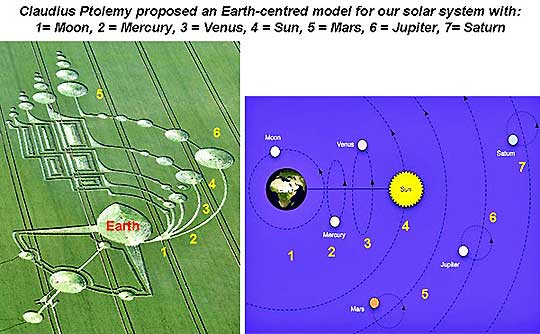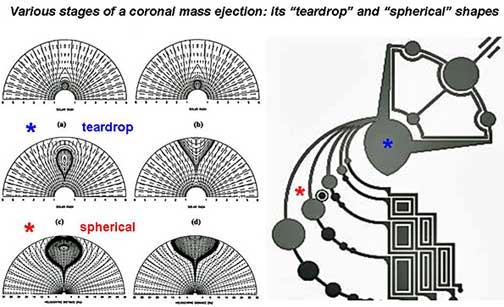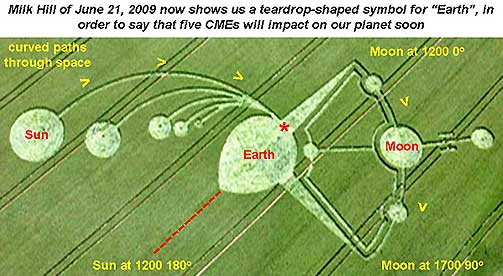
NEW CROP CIRLCES: Part 1: “Alien Symbols” in Milk Hill and South Field
Linda Mounton Howe
(SCROLL DOWN)
*
*
*
*
*
*
*
*
*
*

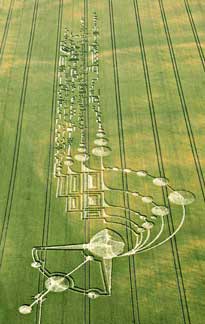
Left: “Alien symbols” crop formation in South Field wheat near Alton Priors, Wiltshire, England,
reported June 27, 2009. Aerial image © 2009 by Julian Gibsone. Right: Milk Hill Summer Solstice
crop formations of June 21 - June 22, with five long lines of “alien symbols” added on in a
third evolution reported June 27, 2009. Aerial image © 2009 by Lucy Pringle.
Images and information by: Cropcircleconnector.
July 2, 2009 Wiltshire County, England - Below Milk Hill's White Horse at 4:30 AM on Summer Solstice Sunday, June 21, 2009, Steve Amor reported to Cropcircleconnector.com that there was a “circle and pattern” in the wheat field there.
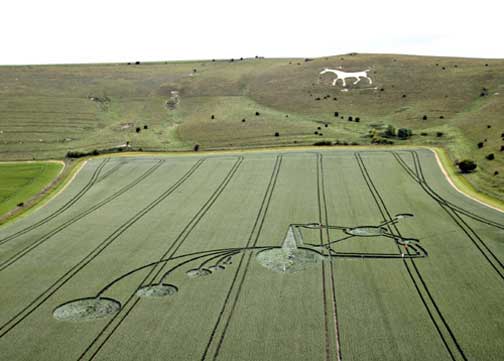
Below Milk Hill's White Horse near Alton Barnes, Wiltshire, England, the pattern above
was first discovered at 4:30 AM on Summer Solstice Sunday, June 21, 2009, and reported to the
Cropcircleconnector.com. Aerial image © 2009 by Lucy Pringle.
The pattern had a teardrop-shaped center with a configuration of four connected circles on one side and five more circles of ascending diameters on arcing lines tethered back to the teardrop center. Then the next morning on June 22, 2009, a more complex addition had been added in the night.
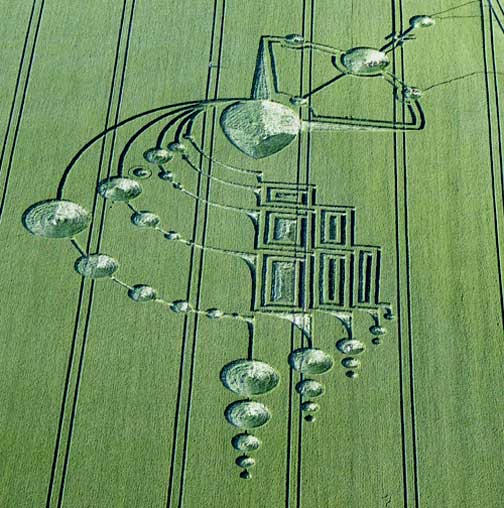
Evolving Milk Hill crop formation with second addition reported
on June 22, 2009. Aerial image © 2009 by Julian Gibsone.
Then five days later on Saturday, June 27, 2009, a third addition was reported. Lines of “alien symbols,” some matching Mayan numbers and characters, extended from the second addition making the wheat formation that evolved from June 21 to June 27, more than 800 feet long.


Upper aerial shows entire Milk Hill “alien symbols” pattern that evolved in three stages from Summer Solstice June 20 - 21, to the long strings of symbols added on June 27, 2009.
Lower aerial enlarges the lines of symbols. Aerial images © 2009 by Julian Gibsone.
Scientists Analyze Milk Hill 1, 2 and 3
An Australian scientist, who requests anonymity, and Mike Reed, retired physicist and telescope engineer at Arizona State University, puzzled over this one for quite awhile. Then the Australian scientist wrote:
“As shown in the explanatory diagram below, Part I of Milk Hill on June 21, clearly looked like a ‘sextant,’ which has long been used to measure the ‘altitude’ or height above the horizon of various astronomical objects in Earth’s sky.”

“It also showed a second underlying symbolism for Earth and Moon where planet Earth was drawn with a ‘teardrop’ shape, while our Moon was drawn with a standard ‘dumbbell’ shape first noted in the early 1990s. That teardrop shape is the usual scientific symbol for a CME, or coronal mass ejection from our Sun.
The two long measuring arms of that ‘sextant’ are aligned in the field close to due north or due east, which match where our Moon will be located (under the horizon) at times of 1200 or 1700 UT on the upcoming date of July 7, 2009.
At first it might seem bizarre that extraterrestrials could be showing us a sextant in English fields, but on several occasions from 2003 to 2008, the crop formation intelligence has showed us an astrolabe, which is another astronomical measuring device from Earth’s past.”
Three separate crop pictures from 2001, 2003 or 2008 all seem to show a generalized
“astrolabe” motif. The astrolabe is an ancient Greek instrument for measuring sky locations
of the Sun, Moon, planets or stars. Sextant, astrolabe and orrery illustrations by
Australian scientist and Italian artist, Marina Sassi.
Another single “astrolabe” crop formation appeared at Gog Magog Hills,
near Cambridge, England, on July 25, 2001.
The Australian scientist explained that two weeks earlier before July 25, 2001, a complicated maze had also emerged at Gog Magog that provided a schedule of eclipses. So, he concluded it was logical that “75 radial segments, along with three crescent-shaped symbols, meant ‘eclipse.’”
He prepared the graphic above and explained that “solar or lunar eclipses appear periodically on Earth once every six months or 25 weeks. Three such sets of eclipse seasons would therefore appear in a total of 3 x 25 = 75 weeks or 1.5 years.”
Milk Hill Part 2 Addition, June 22, 2009
The second addition to Milk Hill on June 22, also seemed to show astronomical symbolism. The Australian scientist concluded that the second addition closely resembles an “orrery,” which is a traditional mechanical device used to illustrate planetary motions.
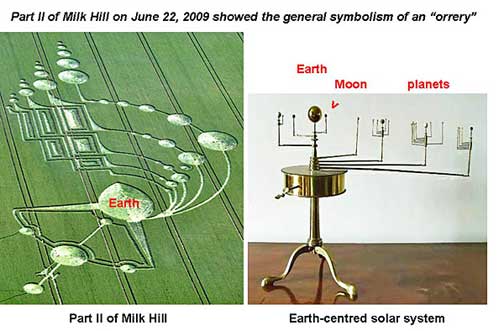
Australian scientist: “This particular orrery seems to be based on the Earth-centered model favored by Claudius Ptolemy in ancient Alexandria (150 A.D.), and taught throughout the Middle Ages, rather than the Sun-centered model introduced by Copernicus in 1540 A.D. We are all familiar today with Copernicus’s heliocentric model for our solar system, which places the Sun at its center and nine planets all around. Yet most people today do not know about Ptolemy’s geocentric model for our solar system, and that is why we have shown it below:
In the right graphic, “Planet Earth lies at its center, while five bright planets along with the Sun and Moon rotate around the outside. The relative order of those seven bright astronomical objects in Ptolemy’s model, when going outward from the center, are 1 = Moon, 2 = Mercury, 3 = Venus, 4 = Sun, 5 = Mars, 6 = Jupiter and 7 = Saturn. On the left, the Milk Hill crop formation with second addition shows curved orbital paths along the right for only five of those astronomical objects: namely 1 = Moon, 2 = Mercury, 3 = Venus, 4 = Sun and 6 = Jupiter. We will discuss below why 5 = Mars and 7 = Saturn might have been omitted.
“Along the top, that Milk Hill crop picture then shows six of seven planetary symbols 1-2-3-4-5-6 (when including the outermost curved line), so as to match six rectangular ‘boxes’ that were drawn immediately below. Clearly those boxes have some connection to Ptolemy’s astronomical objects 1-2-3-4-5-6, but what could their relation be?”
Altitudes Above Or Below Local Horizon
for Moon, Sun and 4 Planets
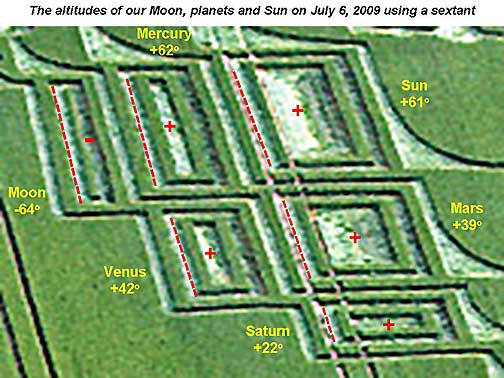
Any box with one stripe means “negative altitude” (below the horizon), while any box with two
stripes means “positive altitude” (above the horizon). Our best date of July 6, 2009, produces
altitudes above or below the local horizon as Moon = - 64 degrees (not visible);
Mercury = + 62 degrees; Sun = + 61 degrees; Venus = + 42 degrees; Mars = + 39 degrees;
or Saturn = + 22 degrees. Planet Jupiter at - 39 degrees is not visible, so is not shown.
On nearby dates, say July 5 or 8, 2009, the negative altitude for our Moon does not
exceed high positive elevations of + 62 or + 61degrees for Mercury or the Sun as required.
“The answer to this apparently difficult problem is actually quite simple: What is the true purpose of a sextant, as shown at Milk Hill one day earlier? Well, a sextant tells how high in the sky any bright astronomical object might be at a given time of observation, in units of 0 degrees to 90 degrees, relative to the local horizon. In astronomical language, those heights in the sky are called ‘altitudes.’
“Could each of those six rectangular boxes be telling us relative altitudes for Ptolemy’s six astronomical objects 1-2-3-4-5-6 at some calendar date in the near future?
“With that idea in mind, we used an astronomical almanac to calculate altitudes for the Sun, Moon and five bright planets over a wide range of dates during the summer of 2009. Then we compared those calculated values with the relative heights of six boxes shown in Part II of Milk Hill. The hourly time of observation clearly has to be close to 1200 UT, since one arm of that crop formation sextant is aligned south to north, parallel to the crop tramlines, while our Sun lies due south at noon in southern England.
“Our best theoretical matches to the crop formation boxes were for upcoming dates of July 6 or 7, 2009. Why would those crop artists go to all the trouble of showing us sextant and orrery shapes, then coding that orrery with six rectangular boxes which mean July 6 or 7, 2009, unless something significant were going to happen at that time?
“At early stages in the ejection process, any Coronal Mass Ejection (CME) on the sun can acquire a teardrop shape, such as that drawn for planet Earth in the Milk Hill sextant marked with a blue asterisk. At late stages in the ejection process, any CME might evolve into a spherical shape, such as that drawn next to the crop formation intelligence's “Sun” symbol marked with a red asterisk.
“If Milk Hill Part II is really telling us about a CME (and not a comet), then that may be why the crop artists omitted 5 = Mars and 7 = Saturn from their curved orbital paths, while including 1-2-3-4-6. On July 6 or 7, both Mars and Saturn will lie angularly offset from the other four planets and our Moon, when viewed in terms of a possible directional CME ejection by our Sun.
“For the past two years, our Sun has been abnormally quiet between solar cycles 23 and 24. Within the past month however, it has become more active. What if anything might happen
shortly?
“Based on previous examples from 2004 or early 2009, we can be pretty sure that the crop formation intelligence's use of a teardrop symbol does represent a coronal mass ejection (CME) from our Sun. Why then would they have drawn planet Earth in the form of a large teardrop on June 21, unless several CMEs will impact upon Earth soon?
“We can see on the left of that new crop picture a round circle for our Sun, which seems to be emitting five CMEs along curved paths through space that eventually intersect with planet Earth at the red asterisk.
“On the right, we can see a dumbbell-shaped symbol for our Moon. The dumbbell moon symbol first appeared in crop formations in the early 1990s. Two long, thin arrows mark where along the horizon our Moon will be located on July 7, at 1200 UT (due north) or 1700 UT (due east). An earlier crop formation at Milk Hill on June 13, 2009, suggested that our Sun would flare late in the afternoon of July 7, at 1700 UT, when it is low in the west at 308 degrees.”

“Jellyfish” or distorted Earth's magnetic field swept by strong solar wind after coronal
mass ejection (CME) from sun lines up with sunset on July 7, 2009, at 308 degrees at
Waylands Smithy near Kingstone Coombs, Oxfordshire, England, reported on May 29, 2009.
Milk Hill Part 3 Addition, June 27, 2009

Five lines of “alien symbols” extend from Part 2 of Milk Hill crop formation
as a Part 3 addition of the evolving and complicated patternwas reported on
Saturday, June 27, 2009. Aerial image © 2009 by Lucy Pringle.
Continued in Part 2: More “Alien Symbols” in South Field



